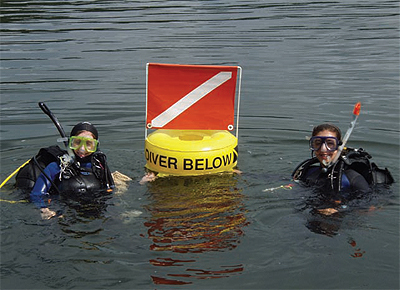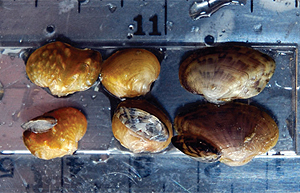WPC Participates in Major Great Lakes Mussel Study
Native species of freshwater mussels that were common throughout the coastal waters of the Great Lakes suffered dramatic declines in the 1990s following the introduction of the zebra mussel. However, initial findings from a comprehensive study of current mussel populations there are encouraging.
Native to Russia, zebra mussels were introduced in the mid-1980s in ballast water discharged by ships. Zebra mussels attach themselves to native mussels, making them vulnerable to environmental stressors such as parasites, disease and lack of food.

WPC Aquatic Ecologists Mary Walsh and Beth Meyer prepare for a timed search for mussels using scuba gear.
Elizabeth Meyer and Mary Walsh, aquatic ecologists of WPC’s Pennsylvania Natural Heritage Program, WPC colleagues and a large group of scientists are studying the health of native mussel habitats in the Great Lakes region.
“We thought there were only a limited number of mussels surviving, yet researchers who have gone to certain places in the Great Lakes region found that many native mussels are actually still persisting,” said Meyer. “There seems to be a particular kind of habitat that is serving as a refuge for them.”
Freshwater mussels are one of the most imperiled organisms in North America. They are highly sensitive to changes in the environment and thus are good indicators of the overall health of an aquatic ecosystem. Historically, 55 mussel species have been identified in the Great Lakes region and 45 species have been recorded around the coastline of Lake Erie.

The grey zebra mussels attach themselves to various types of juvenile mussels.
Funded by the U.S. Fish and Wildlife Services, these extensive research efforts involve scientists conducting field surveys, recording and documenting mussels and their habitats. The data will be collected during the summers of 2011 and 2012.
This year, four WPC staff members worked for three weeks surveying the lower Lake Erie region. They partnered with Dr. Edwin Masteller from the Tom Ridge Environmental Center, who has organized surveys in the Presque Isle area for nearly 20 years.
“In most of our Pennsylvania survey areas, we have good water clarity, so we snorkel and scuba dive to find mussels. But in the western part of Lake Erie, there is no visibility. Those searches are just tactile,” said Meyer.
Led by Dr. David Zanatta from Central Michigan University, collaborators on this project span the Great Lakes region and include several universities, the Great Lakes Science Center, the Pennsylvania Fish and Boat Commission, the New York Department of Environmental Conservation, and the Michigan Natural Features Inventory.
“We visited about 120 coastal sites throughout the Lake Erie region,” said Zanatta. “We found over 2,000 freshwater mussels and 22 different species. It’s a good sign the zebra mussels have not killed everything off. Finding these mussels in the costal areas is going to be really important to determining the overall health of Lake Erie.”
